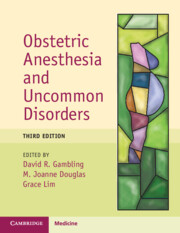Book contents
- Obstetric Anesthesia and Uncommon Disorders
- Obstetric Anesthesia and Uncommon Disorders
- Copyright page
- Cover Illustration
- Epigraph
- Contents
- Preface to Obstetric Anesthesia and Uncommon Disorders, 3rd edition
- Glossary of Common Abbreviations Used in this Text
- Gambling et al.: Obstetric Anesthesia: List of Contributors
- Chapter 1 Obstetric Anesthesia for the Parturient with Complex Medical Diseases
- Chapter 2 Point-of-Care Ultrasound for Obstetrics: Basics and Introductory Chapter
- Chapter 3 FoCUSed Cardiac Ultrasound for Cardiac Disorders
- Chapter 4 Challenging Cardiac Disorders in Pregnancy
- Chapter 5 Uncommon Cardiac Dysrhythmias in Pregnancy
- Chapter 6 Arterial Vascular Diseases
- Chapter 7 Uncommon Respiratory Disorders in Pregnancy
- Chapter 8 Airway Issues
- Chapter 9 Use of Neuraxial Ultrasound for Axial Skeletal Conditions
- Chapter 10 Myopathies and the Parturient
- Chapter 11 Parturients of Short Stature
- Chapter 12 Disorders of the Vertebral Column
- Chapter 13 Miscellaneous Skeletal and Connective Tissue Disorders
- Chapter 14 Disorders of the Central Nervous System in Pregnancy
- Chapter 15 Spinal Cord Disorders
- Chapter 16 Peripheral Neuropathies
- Chapter 17 Disorders of Intermediaries of Metabolism and Malignant Hyperthermia
- Chapter 18 Hepatic Conditions
- Chapter 19 Renal Diseases in Pregnancy
- Chapter 20 Rare Endocrine Disorders
- Chapter 21 Disorders of Blood, Coagulation, and Bone Marrow
- Chapter 22 Infectious Diseases in Pregnancy
- Chapter 23 Dermatologic Conditions in Pregnancy
- Chapter 24 Psychiatric Disorders in Pregnancy
- Chapter 25 Substance Use Disorder
- Chapter 26 Autoimmune Disease
- Chapter 27 Genetic Disorders
- Chapter 28 Anesthesia for Rare Fetal and Placental Conditions
- Index
- Plate Section (PDF Only)
- References
Chapter 27 - Genetic Disorders
Published online by Cambridge University Press: 26 January 2024
- Obstetric Anesthesia and Uncommon Disorders
- Obstetric Anesthesia and Uncommon Disorders
- Copyright page
- Cover Illustration
- Epigraph
- Contents
- Preface to Obstetric Anesthesia and Uncommon Disorders, 3rd edition
- Glossary of Common Abbreviations Used in this Text
- Gambling et al.: Obstetric Anesthesia: List of Contributors
- Chapter 1 Obstetric Anesthesia for the Parturient with Complex Medical Diseases
- Chapter 2 Point-of-Care Ultrasound for Obstetrics: Basics and Introductory Chapter
- Chapter 3 FoCUSed Cardiac Ultrasound for Cardiac Disorders
- Chapter 4 Challenging Cardiac Disorders in Pregnancy
- Chapter 5 Uncommon Cardiac Dysrhythmias in Pregnancy
- Chapter 6 Arterial Vascular Diseases
- Chapter 7 Uncommon Respiratory Disorders in Pregnancy
- Chapter 8 Airway Issues
- Chapter 9 Use of Neuraxial Ultrasound for Axial Skeletal Conditions
- Chapter 10 Myopathies and the Parturient
- Chapter 11 Parturients of Short Stature
- Chapter 12 Disorders of the Vertebral Column
- Chapter 13 Miscellaneous Skeletal and Connective Tissue Disorders
- Chapter 14 Disorders of the Central Nervous System in Pregnancy
- Chapter 15 Spinal Cord Disorders
- Chapter 16 Peripheral Neuropathies
- Chapter 17 Disorders of Intermediaries of Metabolism and Malignant Hyperthermia
- Chapter 18 Hepatic Conditions
- Chapter 19 Renal Diseases in Pregnancy
- Chapter 20 Rare Endocrine Disorders
- Chapter 21 Disorders of Blood, Coagulation, and Bone Marrow
- Chapter 22 Infectious Diseases in Pregnancy
- Chapter 23 Dermatologic Conditions in Pregnancy
- Chapter 24 Psychiatric Disorders in Pregnancy
- Chapter 25 Substance Use Disorder
- Chapter 26 Autoimmune Disease
- Chapter 27 Genetic Disorders
- Chapter 28 Anesthesia for Rare Fetal and Placental Conditions
- Index
- Plate Section (PDF Only)
- References
Summary
Genetic disorders commonly present or show severe manifestations early in life and in reproductive-age women. The impacts of such disorders in pregnancy are complex, often involving both mother and fetus. This chapter provides an overview of key concepts in genetics, focusing on the patterns of inheritance of monogenic disorders. The features and management of several common disorders are discussed, including alpha-1 antitrypsin deficiency, autosomal dominant polycystic kidney disease, Charcot Marie Tooth disease, Ehlers Danlos syndrome, Loeys-Dietz syndrome, glucose-6-phosphate dehydrogenase deficiency, Down syndrome, Turner syndrome, and mitochondrial disorders with a focus on management considerations, relevant for the practice of the obstetric anesthesiologist.
- Type
- Chapter
- Information
- Obstetric Anesthesia and Uncommon Disorders , pp. 443 - 455Publisher: Cambridge University PressPrint publication year: 2024



